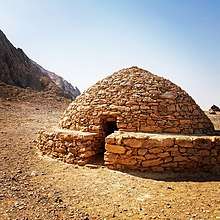Hafit period

The Hafit period defines early Bronze Age human settlement in the United Arab Emirates and Oman in the period from 3200 to 2600 BC. It is named after the distinctive beehive burials first found on Jebel Hafit, a rocky mountain near Al Ain, bordering the Rub Al Khali desert. Hafit period tombs and remains have also been located across the UAE and Oman in sites such as Bidaa bint Saud,[1] Jebel Al-Buhais and Buraimi.[2]
The first find of Hafit era tombs is attributed to the Danish archaeologist PV Glob in 1959, and the first of many excavations of these took place a few years later.[3]
Finds at Jebel Hafit include the remains of some 317 circular stone tombs and settlements from the Hafit period, as well as wells and partially underground Falaj irrigation systems as well as mud brick constructions intended for a range of defensive, domestic and economic purposes. The Al Ain Oasis, in particular, provides evidence of construction and water management enabling the early development of agriculture for five millennia, up until the present day.[4]
Pottery finds at Hafit period sites demonstrate trading links to Mesopotamia, contiguous to the Jemdat Nasr period (3100 - 2900 BC).[3] Evidence of trading links with Mesopotamia are also found in the subsequent Umm Al Nar and Wadi Suq periods of UAE history.
In Al Ain, the Jebel Hafit Desert Park park contains the original necropolis of Hafit Graves which led to the naming of this period in human history in the emirates. A series of ridges leading from the main Jebel Hafit mountain toward Al Ain each contain groups of Hafi tombs.[1]
Bidaa bint Saud, some 25 kilometres north of Al Ain, is also an important location of Hafit period finds.[5]
References

- 1 2 Editor, Samir Salama, Associate (2011-12-30). "Al Ain bears evidence of a culture's ability to adapt". GulfNews. Retrieved 2018-07-16.
- ↑ "Front Matter", The Bronze Age Towers at Bat, Sultanate of Oman, University of Pennsylvania Press, Inc., pp. i–vi, ISBN 9781934536070, retrieved 2018-07-16
- 1 2 Magee, Peter, "Adaptation and Social Formation in Ancient Arabia", The Archaeology of Prehistoric Arabia, Cambridge University Press, pp. 275–278, ISBN 9781139016667, retrieved 2018-07-16
- ↑ Centre, UNESCO World Heritage. "Cultural Sites of Al Ain (Hafit, Hili, Bidaa Bint Saud and Oases Areas)". whc.unesco.org. Retrieved 2018-07-16.
- ↑ "BIDAA BINT SAUD". Abu Dhabi Culture. 2018-01-12. Retrieved 2018-07-16.